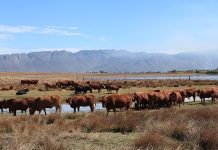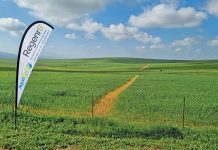In 2005, the image of the Sandveld potato industry was tainted by a barrage of media reports criticising environmental degradation caused by unsustainable farming practices. The negative coverage and a growing environmental awareness have galvanised the industry into action and the need for urgent change has hit home. Since July last year, 51 Sandveld producers have volunteered to participate in the biodiversity best practice initiative of Potatoes SA. O f these, 24 recently completed the pre-audit phase and are now in the process of drawing up environmental management plans and identifying projects that need to be initiated for biodiversity best practice.
Balancing nature with economics
The challenge that farmers face in the Sandveld plays itself out worldwide. On the one hand, the biodiversity of the area is of global significance. Many threatened species in the Sandveld are unique to the area and occur nowhere else in the world. Unsustainable practices can wreck their habitat permanently and endanger farmers’ future livelihoods. n the other hand, economic realities compete with natural habitats. potato industry is the basis of economic activity in the Sandveld. Between 6 000ha and 7 000ha are planted annually for the production of seed potatoes. Producing potatoes for the fresh market and the processing industry employs some 3 250 people. he annual turnover of the industry is around R500 million, making it the main economic activity and principal employer in the region.
The industry is worth some R4 billion a year nationally and is a significant source of employment countrywide. he newly appointed biodiversity best practise manager at Potatoes SA, Sean Ranger, spent five years of his life expanding biodiversity corridors by negotiating with farmers to pledge parts of their land to nature conservation in perpetuity. He’s has been criticised by some for “joining the enemy”, but is adamant that substantial change can only happen if conservationists and farmers work together. “The things that are going wrong in the industry are at the interface between economic desire and environmental pressure,” he explains. “I think solutions at that interface are probably the most important ones to seek if we want to get close to sustainability.” Sean believes biodiversity should be built into the structures of agricultural businesses. “It’s vital that farmers get into biodiversity and business right now. That way they position themselves for markets that are going to be developed in the near future. Becoming compliant takes a long time and the early birds will benefit in a few years’ time.”
What best practice involves
Based on the results of the pre-audit on their farms, farmers will draw up environmental management plans, which will be implemented and audited comprehensively in the future. The environmental pre-audits, to which pilot farmers are currently submitting voluntarily, include several key factors. Farmers earn points if more than 60% of their land still consists of natural vegetation and if it’s invader-free. Farmers are expected to familiarise themselves with the conservation value of natural habitat on their farms. Botanical surveys and the identification of rare plant species are keystones of this aspect of the pre-audit. Rehabilitation of degraded land and alien-clearing are also important.
The biodiversity best practice audit rewards farmers who base the size and timing of plantings on sound financial planning and market analysis and have environmental management plans and policies in place. Farmers are encouraged to obtain base maps of their farms drawn to scale with clearly marked fields, roads, pipes, etc. These maps are essential tools in any biodiversity best practice schedule. Proper fire management systems, which include well-maintained firefighting equipment and training farmworkers in firefighting techniques, are considered vital. Membership of the local Greater Cederberg Fire Protection Association is required. Soil management and irrigation practices also came under scrutiny in the audit. Farmers who have developed potato fields without legal permission have the opportunity to declare their actions and have to follow official procedures to legalise their developments. Since 1998 the law has determined that farmers need official permission before they are allowed to plough natural vegetation.
Under the new National Environmental Management Act massive fines of up to R5 million can be imposed if farmers are not compliant. “Legalising one’s plantings is therefore imperative. Farmers who don’t follow procedures run significant financial risks,” warns Sean. Similarly, water users need to register all water extraction from underground sources and have the registration verified by the Department of Water Affairs. Borehole levels and quality of water need to be monitored and farmers who pay attention to meticulous irrigation scheduling and water quality management are rewarded. The audit also considers integrated pest management and fertilisation practices
Pilot projects
One of the pilot project farmers, Pieter Laubscher, farms near Leipoldtville, close to Lambert’s Bay, and says most of the Sandveld farmers are excited about the project. He sees the biodiversity audit and the draft environmental plans as encouragement to get his house in order. “This initiative encourages greater discipline and responsibility in my business,” Pieter says. “Now that there are formal guidelines, everything’s falling into place. Previously I didn’t know what to do with my empty chemical containers. Now there are specific guidelines that I can follow. I’m also closing unnecessary roads and I think twice about removing unidentified plants, because for all I know, they may be endangered.”
Pieter says attitudes to “problem animals” have changed drastically over the past few years. “Last week a leopard was caught in the vicinity. He’d killed three of my neighbour’s sheep. Back in 1969, all the farmers in the area would have been called up to a hunt for this ‘problem leopard’. Now we look at them with new eyes. I’m excited to have one of the Big Five on my farm!” The same goes for porcupines. Pieter is doing a lot to protect the porcupines on his land. “I have fenced off 1 500ha as a protected area, but the challenge is to change the attitudes of my workers as well. I battle to convince them not to kill the porcupines. I always thought they hunted them for meat, but last week one of my workers said he had a very good market for quills in Cape Town!”
Spatial analysis Buffer zones of more than 50m between irrigated fields and natural river systems are essential for biodiversity protection because run-off from fields often wreaks havoc in natural river systems. Equally important is the creation of biodiversity corridors wider than 20m between potato fields. Sean explains the importance of these corridors. “It’s vital to understand how ecological processes function spatially and how species move through the landscape. One has to understand where corridors need to be. Certain bees, for example, can’t fly further than 500m to pollinate plants, so if there aren’t sufficient pockets of natural vegetation between potato fields, and if the natural vegetation in the landscape is too fragmented, no cross-pollination takes place.
Next thing one starts seeing extinction spirals.” Spatial analysis is about more than corridors between potato fields on a particular farm. The whole Sandveld, including farms and natural habitats, form part of an integrated system – a web of spatial, social, economic and biological relationships. Within this landscape there are humans, plants and animals; it’s important that the humans understand the effects their agricultural activities are having on other life forms. The Cape leopard, for example, has migration routes between the Olifants River Mountains and the Piketberg Mountains.
Along these routes there are particularly sensitive connector corridors, that need to be preserved. Furthermore, spatial planning in the Sandveld needs to take into account the threat of global warming. “If species have to adapt to global climate change, they need large altitudinal gradient variations. This means that you need to create biodiversity corridors between the sea and the mountains, which will allow insects and plant species, for example, to move to high-lying areas, should their lower-lying habitats be threatened by climate change,” Sean explains.
Incentive systems
Contract reserves are vital to the creation of biodiversity corridors. Five years ago Sean, who was then contracted to Cape Nature’s Greater Cederberg Biodiversity Corridor (GCBC), started ground-breaking negotiations with farmers, who received various incentives In exchange for setting aside sensitive natural vegetation as conservation areas, sometimes in perpetuity. “For declared contract nature reserves there is a 100% rates rebate,” explains Sean. “Farmers are also supported with technical assistance.
The GCBC is lobbying for additional incentives on their behalf or by aligning the project to other sources of funding such as the current Working for Wetlands Programme, which has cleaned up a large portion of the Verlorenvlei catchment, creating jobs for local people.” Farmers who’ve entered or who are about to enter into contract reserve agreements with CapeNature qualify for Platinum status under the new biodiversity best practice system, if they agree to set aside 100ha or more. However, they have to have all the required environmental authorisations from Environmental Affairs and the National Department of Agriculture in place. The biodiversity best practice initiative also links into another project called the GreenChoice Alliance. It’s a joint venture between Conservation International and World Wide Fund For Nature.
GreenChoice will provide coordinated communication with international trade and local produce markets, retailers and consumers. Sophie Susman of GreenChoice says, “The idea is not to sell potatoes in isolation but as part of a whole basket of environmentally responsible produce. We have approached retailers such as Woolworths, Massmart and Pick ‘n Pay and they have shown keen interest. Woolworths and Pick ‘n Pay actually helped fund the development of the guidelines. But they still have to test if selling more environmentally responsible goods is a feasible business decision, while the farmers still need to complete and pass the final audits.”
Sean is positive about the future of biodiversity best practice in the economic success of the potato industry, “This industry is taking control. Collectively, we are creating a group of biodiversity-conscious producers who will be a safer group to invest in because there are checks and balances in place.” For more information contact Potatoes SA on 012 349 1906/7. |fw








